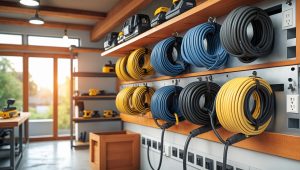Introduction: Why Extension Cord Safety Matters More Than You Think
Extension cords are the unsung heroes of home repairs, upgrades, and DIY projects. Whether you’re running a power tool in the garage, plugging in a shop vac on the patio, or charging gadgets in a temporary workspace, extension cords bridge the gap between electrical outlets and productivity. Yet, their everyday utility often leads to overlooked risks. According to the Electrical Safety Foundation International (ESFI), extension cords are responsible for an estimated 3,300 home fires, 50 deaths, and over 270 injuries annually in the United States alone. Most of these incidents are preventable with the right knowledge and equipment.
Many homeowners underestimate the importance of choosing the correct cord, using it properly, and recognizing signs of wear. The wrong extension cord can overheat, trip breakers, damage expensive tools, or spark a dangerous fire. Conversely, the right cord can make your DIY life easier, safer, and more efficient—especially when you select models designed for heavy-duty use and demanding environments. This guide dives deep into extension cord safety, practical dos and don’ts, and a hands-on review of the best heavy-duty picks for homeowners. Whether you’re a seasoned DIYer or just starting your home repair journey, these tips will help you avoid common mistakes, extend the life of your tools, and keep your family safe.
Understanding Extension Cord Ratings and Types
Wire Gauge (AWG) and Ampacity: What You Need to Know
The effectiveness and safety of an extension cord depend largely on its wire gauge—measured in American Wire Gauge (AWG). The lower the AWG number, the thicker the wire and the more current it can safely handle. For example:
- 16 AWG: Light-duty. Max 10 Amps. Suitable for lamps, clocks, and small electronics.
- 14 AWG: Medium-duty. Max 13 Amps. Suitable for power tools, kitchen appliances.
- 12 AWG: Heavy-duty. Max 15 Amps. Suitable for space heaters, air compressors, and high-power tools.
- 10 AWG: Extra heavy-duty. Max 20-30 Amps. Used for industrial-grade tools and equipment.
Never exceed the cord’s rated amperage—doing so causes overheating and fire risks. Always check your tool’s amperage (often listed on the label or in the manual) and match it with an appropriately rated cord.
Indoor vs. Outdoor Extension Cords
Outdoor cords are built for durability, moisture resistance, and UV protection. Look for cords labeled “W” or “W-A” (weather-resistant) and “SJTW” (hard service, thermoplastic, weather-resistant jacket). Indoor cords are typically thinner and lack weatherproofing, making them unsafe for outdoor use or high-moisture environments.
Length and Voltage Drop
Longer cords create more resistance, leading to voltage drop. This can cause tools to underperform or overheat. As a rule:
- For tools rated under 10 Amps, limit cord length to 50 feet (16 AWG) or 100 feet (14 AWG).
- For tools over 10 Amps, use 12 AWG or thicker for lengths over 50 feet.
When in doubt, choose a shorter and thicker cord for maximum safety and performance.
Essential Extension Cord Dos and Don’ts
Dos: Best Practices for Safe Use
- Inspect before every use: Look for nicks, frays, cracked insulation, or bent prongs. Damaged cords must be replaced immediately.
- Use grounded cords: Three-prong plugs (with a grounding pin) are essential for power tools and appliances with metal shells.
- Uncoil cords fully: Coiled cords can overheat under heavy loads. Always unroll before use.
- Store cords properly: Coil loosely and hang on a wall hook or cord reel. Avoid sharp bends or tight knots that can break internal wires.
- Choose the right cord for the job: Match the AWG, length, and indoor/outdoor rating to your specific task.
- Plug into GFCI outlets: Especially important in garages, basements, and outdoors to prevent shock hazards.
- Label and organize: Mark heavy-duty cords for workshop use, and keep light-duty cords for electronics only.
Don’ts: Common Hazards to Avoid
- Don’t daisy-chain cords: Plugging one extension cord into another increases resistance and fire risk.
- Don’t run cords under rugs, carpets, or doors: Hidden cords overheat and are prone to damage from foot traffic.
- Don’t alter plugs or cut off grounding pins: This defeats built-in safety features and can lead to shocks or equipment damage.
- Don’t overload: Never exceed the cord’s maximum amp rating, even if appliances are running intermittently.
- Don’t use indoor cords outside: Lack of weatherproofing leads to cracking, short circuits, and shock risks.
- Don’t ignore warmth: If a cord feels hot to the touch, unplug immediately and reassess your setup.
Heavy-Duty Extension Cord Reviews: Top Picks for Home Workshops
Review Criteria
For this review, we focused on cords rated 12 AWG or thicker, with grounded plugs, weather-resistant jackets, and lengths suitable for workshops and garages (25–100 feet). We considered build quality, flexibility in cold weather, durability, and price.
1. Iron Forge Cable 12/3 SJTW Heavy-Duty Extension Cord
- Specs: 12 AWG, 15A, 125V, 50 ft, lighted end, weather-resistant jacket
- Pros: Thick, durable insulation; power indicator light; stays flexible in cold; reinforced strain relief; UL listed
- Cons: Bulky for storage; lighted end may crack if dropped repeatedly
- Best for: General workshop use, outdoor power tools, shop vacs, pressure washers
2. Southwire 2588SW 10/3 Heavy-Duty Outdoor Extension Cord
- Specs: 10 AWG, 15A, 125V, 100 ft, weather-resistant, lighted ends
- Pros: Industrial-grade durability; minimal voltage drop even at 100 ft; stays flexible in winter; bright colors for visibility
- Cons: Expensive; heavier than most; overkill for light-duty tasks
- Best for: High-power tools, portable generators, multiple-tool setups far from outlets
3. US Wire & Cable 74050 12/3 SJTW Yellow Extension Cord
- Specs: 12 AWG, 15A, 50 ft, weatherproof, oil and chemical resistant
- Pros: Ultra-flexible jacket; easy to coil; handles oil and grease well; clear, bright yellow color
- Cons: No lighted end; jacket can scuff after frequent outdoor dragging
- Best for: Garage workshops, automotive repairs, outdoor lighting setups
4. Flexzilla Pro Heavy-Duty Extension Cord with Lighted Ends
- Specs: 12 AWG, 15A, 25 ft, cold-weather flexibility (-58°F), water-resistant
- Pros: Stays supple in extreme cold; rugged molded ends; lighted plug; tangle-free
- Cons: Shorter length; pricier than generic cords; green sheath may show dirt
- Best for: Short-range heavy-duty use, snowblower or outdoor power tool connections in winter
5. Voltec Power & Lighting 05-00364 Multi-Outlet Contractor Cord
- Specs: 12 AWG, 15A, 50 ft, triple-tap outlet, weather-resistant, contractor grade
- Pros: Multiple outlets at the end; heavy-duty build; bright blue color; excellent strain relief; ETL listed
- Cons: Slightly stiff when new; triple outlet adds bulk to the end
- Best for: Running multiple tools, outdoor events, workshop setups with limited outlets
Honorable Mentions
- Amazon Basics 12/3 Outdoor Extension Cord: Affordable, reliable, with good flexibility.
- Woods 982452 12/3 SJTW Extension Cord: Reinforced blades, solid value for the price.
DIY Extension Cord Management: Storage, Organization, and Longevity
Proper Storage Techniques
How you store your extension cords directly affects their lifespan. Avoid wrapping tightly around your arm or elbow—this stresses the internal wires and creates permanent kinks. Instead:
- Over-Under Coil Method: Alternately loop the cord in opposite directions. This balances twists and prevents tangling.
- Use Cord Reels or Hangers: Wall-mounted reels, hooks, or even large Velcro straps keep cords off the floor and away from sharp objects or water.
- Separate by Use: Dedicate specific hooks for indoor, outdoor, and heavy-duty cords to prevent accidental misuse.
Troubleshooting and Repair
Never use electrical tape for permanent repairs. If you notice a frayed section or damaged plug:
- Replace the cord entirely if the damage is near the plug or multiple areas are affected.
- Install a new plug only if you have experience and the damage is limited to the end.
- Dispose of cords properly—never throw in regular trash if they contain significant copper. Recycle at an e-waste center when possible.
Extension Cord Accessories: Must-Have Gadgets for Safety and Convenience
- GFCI Inline Adapters: Add ground fault protection to any cord, especially for outdoor or damp locations.
- Cord Locks: Prevent accidental unplugging during heavy tool use.
- Weatherproof Covers: Snap-on covers shield plugs and outlets from rain or snow during outdoor projects.
- Smart Plugs and Timers: Automate power control and monitor tool usage remotely.
Frequently Asked Questions on Extension Cord Safety
- Can I use an extension cord with a space heater? Only if it’s a heavy-duty (12 AWG or thicker) cord and kept fully uncoiled. Space heaters should ideally be plugged directly into a wall outlet.
- Why does my extension cord get warm? Likely due to excessive load, inadequate gauge, coiling, or damage. Unplug and reassess immediately.
- Can I bury an extension cord? No. For permanent outdoor wiring, use UF-rated cable installed to code—never standard extension cords.
- Is it safe to leave an extension cord plugged in? Not for long-term use. Unplug when not in use, especially outdoors or in damp areas.
Conclusion: Make Smart, Safe Choices for Every Home Project
Extension cords may seem like a simple purchase, but their impact on your home’s safety, convenience, and the longevity of your tools is significant. By understanding the basics—matching gauge to load, choosing cords rated for your environment, and following best practices for use and storage—you’ll dramatically reduce the risk of fire, electrical shock, and costly equipment damage. Investing in high-quality, heavy-duty cords is not just about handling bigger loads; it’s about building resilience and safety into every project, from routine maintenance to ambitious upgrades.
Don’t take shortcuts: always inspect your cords, avoid daisy-chaining, and never push a cord beyond its limits. Organize your extension cord collection so the right cord is always at hand, and consider handy accessories like GFCI adapters or weatherproof covers to adapt to any scenario. Remember, a well-managed extension cord setup isn’t just about compliance or convenience—it’s about protecting your home, your family, and your investments.
With the knowledge and recommendations in this guide, you’re equipped to choose, use, and care for extension cords with confidence. Make smart choices, stay safe, and let your DIY ambitions thrive—powered responsibly.









I noticed you mentioned that 16 AWG cords are only suitable for light-duty use, but could you clarify if it’s ever safe to use a light-duty cord for something like a shop vac just for a quick job? Or is it always best to stick with heavier gauges even for short tasks?
It’s best to stick with a heavier gauge cord, such as 12 or 14 AWG, for a shop vac, even for quick tasks. Shop vacuums draw a lot of power, which can overheat a 16 AWG light-duty cord and create a fire risk. Using the right cord ensures your safety and protects your equipment.
Do heavy-duty extension cords for outdoor use last longer if I store them inside when not using them? Or is it mostly about the wire gauge and type, and not so much about storage? I want to get the most life out of my cords.
Storing heavy-duty outdoor extension cords inside when they’re not in use does help them last longer. Indoor storage protects them from sun, moisture, and extreme temperatures, all of which can degrade the cord over time. While wire gauge and type are important for performance and safety, good storage habits can definitely extend the life of your cords.